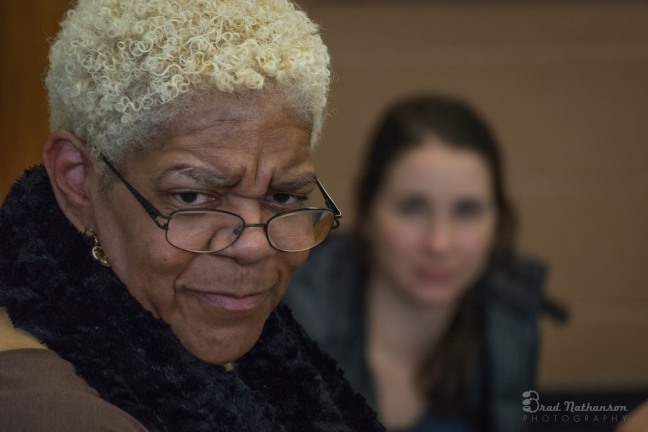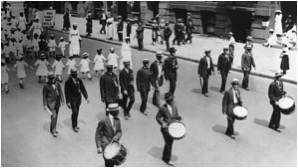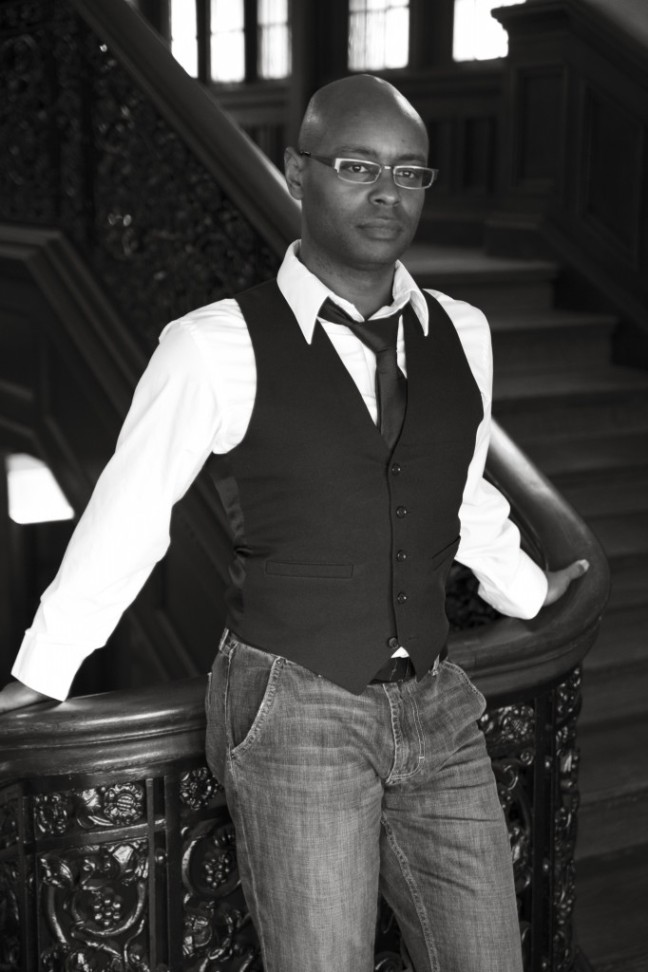Kim Massie is an incredibly versatile vocalist from St. Louis; from blues and gospel to rock and pop, she can sing nearly anything, and she’s sung at many respected venues around the USA. She’s been twice awarded the Best Female Vocalist of the Year Award from the Riverfront Times, and made her television debut singing “I Finally Forgot Your Name” on TNT’s Good Behavior. What follows are excerpts from a transcript of the lecture she gave to a group at BluesGeek 2018, transcribed by Chelsea Adams, and edited for length and clarity. All photographs are courtesy of BluesGeek and Brad Nathanson Photography.
On Her Musical Start
The gospel thing I’ve been doing it all my life: Singing gospel since I was nine years old, going to church. One time I was in five choirs because I loved music that much and at the time, there was nothing much for teenagers. I was a teenager, I was 14, 15, in the choir in middle school and special choir and trio and all that, and I couldn’t get enough of the music.
In the 90s, I didn’t sing with bands, I did what was called band in a box. I did a lot of karaoke, and I did a lot of that when I first started in 1992. And I would go around, and I would love it at that time. I would go into bars and it was the canned music. So in ‘92 up until I came to St. Louis I was doing that. That’s where I was. And I’m glad that I moved from a bad relationship from Ohio to St. Louis, and I’m so glad that he dumped me.
You know, we do things for various reasons, and sometimes we stay and become complacent at times until something happens to make us say get me to try something else. I’m glad the relationship did break up, because I went someplace different, and my mother and my grandmother live in the St. Louis area, perfect for me to come. I actually got with, I went to hear this band, that band, and I got asked to sit in, and eventually I was asked to be a guest singer, and then asked to have my own band, and I was scared as hell trying to transition from a band in a box where you’re looking at the words on the screen to actually singing.
I’ve got to be creative now. I’ve got to try to make this room work for me. And that was a hard thing to do, but I have a passion for the music to the point where I can walk into a room like this and I can just go “Lookin’ out, on the morning rain. I used to feel, so uninspired. And when I knew, I had to face another day, Lord made me feel so tired.” And it’s true that the passion that I have for this thing called music, I feel it so deeply, I feel it, I almost want to cry. That’s how it’s affected me, and I know if it affects me like this, what is it doing to you?
How awesome is that, to have that kind of gift? To be blessed like that? And I don’t take advantage of it, not one bit. I really don’t because I was an introvert. I was scared to sing in front of people, for real. I couldn’t look at you like this. So the way it evolved for me is that it also enriched me like you wouldn’t believe. It has given me confidence and shown me where I’m able, there are some people, you feel that connection, you just want to talk to me and tell me your whole life story, and guess what? I’ll listen. And I crave it, I love it, every time I come into contact with a group of folks. Ain’t that something?
And I keep singing because I couldn’t imagine being a little girl, having dreams of singing, that I would actually be able to sustain a career, everybody should have a job that they love, that they look forward to. And it just seemed like it came so naturally for me. I’m so fortunate to have had this opportunity. I’ve been making my living for 17 years singing. That’s my nine to five, 17 years.
On Transitioning from Karaoke to Singing with a Live Band
Baby let me tell you! See, it’s a different thing where your words are right there. Your words are right there, so you can do your thing, and your words are right there. But with a live band you have to right now on the spot, do a song that we just rehearsed the other day, and you’re not really sure if you know all the words. That was the hardest transition. And I would freeze up a little bit. But what happened was this: over the years I grew more comfortable with myself because I’m a big woman, and by the way I’ve lost 150 pounds, and I had some health issues but I feel a whole lot better. I was a little intimidated being on stage being a big woman and thinking, no one want to see this big woman up here singing. Once I got past that, I could stand up here and do whatever, except for dropping it like it’s hot. I got bad knees!
I made my mistakes. What I did, for real, when I sing a song, I would forget the words, I would do, I was always taught, never let the song die, so when I’d go and do, let me see, give me a song, name a song. Dr. Feelgood?
“I don’t want nobody, always” I forget the words “. . . duh duh duh, oooooh yeah!” So when I did that, everybody would laugh, and I got through it. I used to be a perfectionist when it came to my singing back in the day to a degree, but I’m not so hard on myself when I make a mistake. Okay. I’ll start singing something else. Something to get through that song, so over time, I wasn’t afraid because I could play. Last night when we did the “Push it Real Good” what we was supposed to be doing was something else, but I decided to go back and do something else. And I didn’t know all the words, so I went so far with the song and told the band stop, okay, now let’s go do this other song, so, there you go. I’m not afraid to make a mistake because I can always regroup, and I feel confident.
Initially, when Bud approached me to sing at Beale on Broadway, he had just opened up his place in 2000, and in 2001 he asked me to be in one of his ads, and he put the thing together. That being said, I had a problem with the band that was playing with me, doing the same 25 songs to dance to. I got frustrated and said, “Can we do Karaoke?” And he said, “That scares me, why?” And I said, “Either they don’t want to learn any new music or they’re not able to,” and of course, we all have our limitations, so with that, what he did was he got rid of the whole band and got me new people, someone who could do what I needed done. People were asking can you do so and so? Can you do that? And a man who asked “can you do A Whole Lot of Love?” And see at that time I was kind of feeling out the band, I didn’t know what they could do, but they would surprise me every time. So all of a sudden, the band would go, and I could sing. That is where they came from, where I decided the audience picks my songs. Most of the time it works, sometimes it don’t.
I get all kind of incentive when my tip jar fills up. It’s amazing, amazing. I can bring some notes from places you wouldn’t believe. Awesome! And so yes, I love that being able to just have my audience here and not have a song list, because you might be feeling like some blues, but you might be feeling Billy Joel, and you might be feeling like “I can’t stand the rain against my window bringing back sweet memories!” So you all have your own, bring yourself, and I like to build, to connect with that, and you go home saying, hey, that was alright! And you bring someone back with you, and I tell folks, your lives will never be the same after Kim Massie. And you call it arrogant if you want but I just call it confidence because I feel so good about what I do, and can’t nobody take this from me, nobody.
On Blues and Musical Connection
People got problems all the time. You know what I’m saying? All the damn time. My dog died. I got evicted. And my car just got stole. My car did get stolen a couple months ago. So that thing of just going oh, I don’t want to think about it for a minute. I think that, deep down, and when I talk to people, and they are so interesting, who they are, where they come from. Why are you paying to see me? What can I do for you? You know what I’m saying? So it just leaves me, and I wasn’t a blues per se, singer.

I don’t like to be stereotyped into one genre of music. You see a black woman, here, I will just do blues. Or gospel. I do blues, jazz, gospel, R&B because I don’t ever want to limit myself, and once I limit myself, it doesn’t make me happy, and I want to be able to be free and able to express myself whatever way that evening dictates. So I never have a song list. You never see me with a song list. You might see me with a reference. One thing I did in particular, it was a birthday party for a young lady, and they wanted all Aretha Franklin. I sang Aretha Franklin five songs in, and I noticed no one was listening to me, for real. And I looked around, and I said okay, hang on, and I switched it up. I did some blues, straight up blues, and I got the whole room, got their attention. You just have to be connected with your audience and see if they’d like some rock and roll, maybe. I’m just saying. For some reason you kind of remind me of Billy Joel. I feel like I want to sing “Don’t go changing, to try to please me!” I get motivated by all of you. I see someone smile and it grasps me, and I’m like oh, okay. So it’ll take me somewhere else, where I was planning on going this way, and that’s what I love about what I do.
Do you give yourself goosebumps?
Yes I do! Let me tell you, that’s how I know that I’ve got my connection with my audience, because whenever I sing, I’ll do maybe five, six, seven songs and not get a bump, but that next song, it’s just something about how I’m doing the song, and what I’m feeling coming to me, because you exude energy, you really do, and I grab that energy, and when I get the goosebumps, I got the goosebumps now talking about this, and that’s what that is, that’s my radar, when I get the goosebumps, I’m feeling it. And I try to share this with my audience, you know what, I just sang five songs and haven’t got a goosebump yet. What’s up? Y’all need one more drink? Let’s make this work, and it will kind of turn around.
On Having Thyroid Surgery and Cancer
Back in 2013, I had a thyroid surgery, which was close to the vocal chords, and yes I was very, very scared, and I even paid for a device to monitor during the surgery to make sure that they didn’t touch the vocal chords. The operation, the heal time, was like five to seven days, and I was singing in ten days after my surgery. I was very scared, very scared that my voice wouldn’t come back and the doctor said it would take a good year for me to be reacquainted with my voice, and I had my whole thyroid removed. It was ten times the size of a regular thyroid and it was choking me so when the thing was removed my head was kind of wobbly.
And so within that year, my voice actually did come back even stronger. I could sing without ceasing, for like two hours straight with my band. We have done this. And sometimes we’ve done three hours straight with no break, and I notice in the first hour before my surgery, it was hard for me to, it was a struggle, I was fatigued and sure enough, I had cancer. And had it all removed, and I get checked every year but so far everything is good. But I was just so scared with that.
Advice for New Singers

Record yourself. Get your phone and just start singing a song that you like and listen to yourself. And if your ears are trained, tuned, or whatever, you can hear things that might be wrong. I did that with myself fin 1982 and I’ll never forget it. I hated it. And I am self-taught by the way. I don’t have any formal training like going to school. I’m self-taught. I was a fan of Aretha Franklin, Luther Vandross, Whitney Houston, and so what I did was try to mimic what they did, and once I so-called perfected it, I would only put my own, myself into that. So listen to yourself, record yourself. I paid attention more, because sometimes you don’t pay attention to how you’re singing something, and you have to pay attention. Know how you want to start and end a sentence. Know where you’re going to end. Know what you’re going to be doing, and practice, practice, practice. Listen to yourself. Get comfortable with hearing your voice, and I think that you’ll see some improvement. And get with somebody that you trust, not your mamma, not your daddy, okay? Get with someone who has a trained ear who will tell you the truth. The best thing they can do is tell you the truth. Don’t sugarcoat it. That puts you in a false sense of security, and I think that you will correct yourself. You might do that.
On Writing Her First Song
I wrote a song. And I have copies of the song here. I have, it’s a compilation CD that was put out by the St. Louis Blues Society. It was titled 17 at 17, and I was asked to do an original song and I did, and the song was titled “Little Girl Lost,” and it came out of inspiration. I have a great granddaughter who is five years old, a beautiful thing, and her grandmother was my daughter. They all lived with me, and she turns six this month. We’ve had her since she was two because her parents were drug addicts: that’s my grandson, her father, and her mother has not spoken to her in two years. And this started as a temporary thing so the mother could get clean, but now she is with us, and my daughter took some pictures of her at age two, and when I looked at the pictures, I knew what I would write about. It spoke to me. This one was very, very heartfelt, and the music to it, and my goal is to bring awareness, more awareness with what’s going on, grandparents raising children. It’s terrible, but it’s happening to these children; they’re lost. And at the end of the song I say, little girl, found. Okay? I’m very proud of that, that somebody told me a long time ago, before I even thought about this, that you’re an entertainer, you sing. So don’t tell me you can’t do that. And I shied away from it, but I’m inspired, and I’m going to be doing more. I’m doing a CD. We’re going to be working on my own collection. I’m really happy about that.
On Filming Good Behavior
And, oh! I was in a movie! Yes, I was! Not one of those kinds of movies. That’d be the first thing the keyboard player would say. In 2015, I was in a movie called Good Behavior on the TNT network, and I played the role of a blues singer. Such a stretch, right? Oh my god. And the gentleman that saw me was one of the producers of the Behavior, and he came to see me with the summer theater thing in St. Louis at Forest Park. The Muni. They brought him to see me and he liked me, and within two weeks I was in North Carolina, and he, I just had to do one song and it was Long Tall Deb, entitled “I Finally Forgot Your Name.” So you can still see it. I’m still getting residual checks. It was a lovely thing, I’ll tell you. The song itself is just for y’all. It’s for y’all. You’re going to love it. But the 21 minutes and 16 seconds into the movie is where you hear it. You’ll hear my voice first, and I’m actually singing the whole song throughout this one little thing with the main characters are talking and you can see me in the background. I spent 7 hours on stage doing one damn song. And then they said break time! Break time? I’m ready to go home! It’s midnight! I gotta go! But it was an awesome experience and I would love to do it again. It’s called Good Behavior, the first episode, “So You’re not a School Teacher.” It’s back on. So check it out.
What do you wish you could go back and change?
I wish I had done it sooner. I wish I had done this sooner. Because, and look, also, my career started when, actually started I feel, when I turned 40. I’m going to be 60 this year. I was very young when I had my children. I was a teenage mother, and so during that time, I would have done things different, so that I started my career earlier, but then who knows who I would be as far as—and I’m not talking about prestige or status—I’m talking about me, who knows where I would have been had I started earlier. You know?
I think things happen when they’re supposed to happen, and it’s not about what you go through; it’s how you deal with what you go through. And I tell my children, my grandchildren, I have great grandchildren, too, and let them know that it’s integrity, integrity. I have a good rapport with my band and audiences, and I’m not goody two shoes, I just believe in treating people right and the good you put out, it comes back. And I have been so enriched by doing this thing called music, that when I see the looks on your faces when I’m doing what I’m doing, oh yeah.
When you all get to dancing, I get goosebumps on my arms, yes, yes, I got them! And then it just empowers me, and when I see this going on, no telling what it’s doing for you, okay? You might go out and go do something, go climb a mountain or something! It gives that oomph, and we need that, we really do. Some of us become so complacent with no energy and things. We have some folks that are self-motivators, and I like to think that I can help motivate you to attain your goal. I have a saying among many sayings: Aspire, inspire, before you expire. I wish that was mine. I read that someplace and I was like wow, so that’s what I’m about.





























